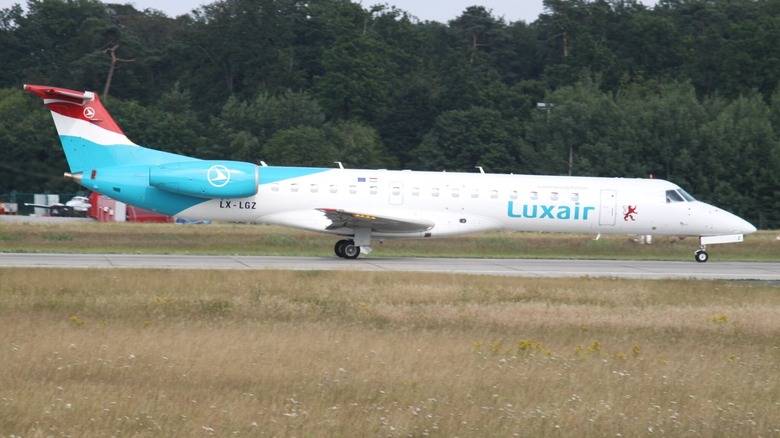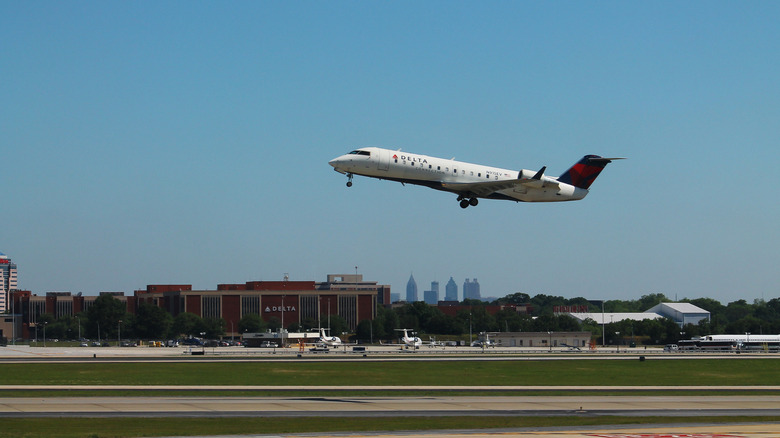What Is The Smallest Commercial Jet Flying In The US & How Many Passengers Can It Carry?
When most travelers think of commercial jets, they probably imagine one of the biggest jets ever made carrying hundreds of passengers. However, as frequent flyers already know, commercial jets can also be small, such as the two smallest currently flying in the United States. These planes, the 98-foot Embraer ERJ-145 and the 87-foot Bombardier CRJ-200, are both 50-seaters and flown regionally. They were designed specifically for short-haul and regional routes, which gives airlines the ability to connect smaller airports to major hubs. Technically, the 30-seat Embraer ERJ-135, flown by carriers like Contour Airlines, is even smaller, but the 50-seat ERJ-145 and CRJ-200 are the smallest jets still widely used in U.S. commercial service.
The Embraer ERJ-145 and the Bombardier CRJ-200 both entered service in the 1990s and became an important tool to regional carriers, which often operated flights on behalf of larger airlines under names like American Eagle or United Express. Because of their seating capacity, these aircraft are officially considered the smallest jets in regular scheduled service, since newer regional airplanes are built to seat roughly 70 to 100 passengers. Executive or private business jets can be smaller, but they are excluded from the commercial airline discussion, ultimately making the ERJ-145 and CRJ-200 unique as the true smallest commercial jets flying passengers in the United States.
Cabin layouts and passenger experience
Although both the ERJ-145 and CRJ-200 carry around 50 passengers, it's how they arrange the inside of these jets that makes them feel very different. For instance, the Embraer ERJ-145 uses a 1 to 2 seating layout, with just a single seat on one side of the aisle and two on the other. This is a strategic setup because it gives solo travelers an option to sit by themselves for privacy and creates a distinctive, narrow feel to the cabin. The Bombardier CRJ-200, on the other hand, uses a more conventional 2 by 2 design, with two seats on each side of the aisle, which basically feels like a larger aircraft in a smaller package.
As you might expect, both cabins are much tighter than regular jets, but that smaller scale has its own advantages. For starters, boarding and deplaning are a breeze, since there are fewer seats to fill, and the lighter structure allows the aircraft to use shorter runways for takeoff and landing. Despite its small size, their cabin designs were built for efficiency, blending comfort and practicality while helping airlines maximize profits.
The role they play today and the CRJ-200's retirement
The ERJ-145 and CRJ-200 bring more value to the table than just their small size and efficiency; they are a critical part of how U.S. airlines keep the country connected. Their purposeful 50-seat capacity makes it possible to serve airports that simply can't handle larger aircraft or just do not have enough demand to fill them. Regional airlines use these tiny commercial jets to link smaller towns and cities to larger hubs, feeding passengers into the nationwide air network. If they didn't exist, many routes would be unprofitable, leaving travelers in less populated areas virtually out of options.
It's the jet's versatility that keeps routes functioning; they also help facilitate access for communities that rely on safe air travel for business opportunities, medical needs, or family connections, ensuring America's skies remain open to travelers from every corner of the country. The ERJ-145 continues to see widespread use in this role, but the CRJ-200 is fading from the picture. Delta and its regional arm, Endeavor Air, retired it in 2023, and American Eagle will end its final CRJ-200 flying with Air Wisconsin in April 2025. After that, the aircraft's presence will be limited to smaller carriers and niche operations such as Essential Air Service or charter flights, marking the close of its mainstream career.


